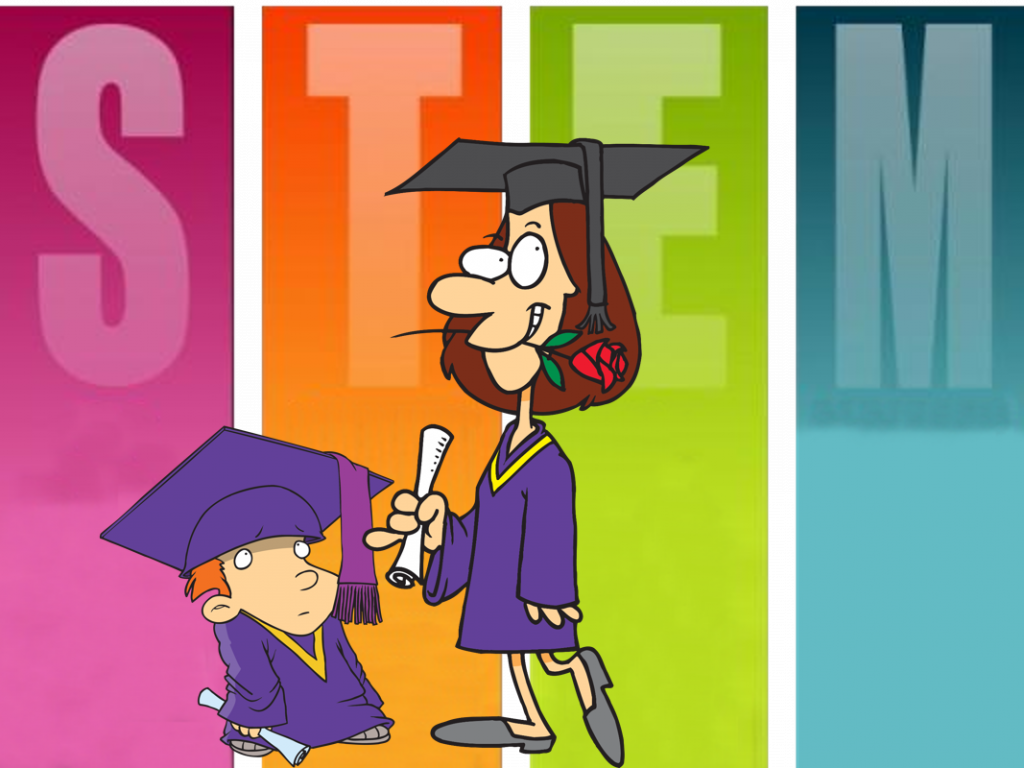Even the most casual observer of the human condition understands the world continues to become more technologically advanced. In spite of a few eras during which humankind’s knowledge regressed, technological advancement is a trend that helps define human history. Common sense tells us our children need to be prepared to succeed in a technology-based world; yet, many pundits insist Industrial Age education models are keeping us from achieving that goal. Jay Bayne, chairman of the Milwaukee Institute, writes, “In the 21st century, our educational systems, from pre-K through K-20, are in need of a substantial upgrade. As a popular and contemporary component, our emphasis on STEM education (science, technology, engineering and mathematics) remains relevant. Its implementation, however, needs revision.”[1] Attorney and consultant Malcolm Kushner notes, “The country that leads in STEM will lead the world! And that’s the problem: America isn’t #1 in STEM. We’re not even close.”[2] When I and a few colleagues sensed America was losing its competitive edge, we founded The Project for STEM Competitiveness — a project-based, problem-solving approach to STEM Education that helps schools near where we live demonstrate to students that STEM subjects can be fun and applicable in their lives. We fully understand our humble efforts won’t solve the national challenge, but it’s a start. The point is: It’s time to reimagine STEM education from bottom to top.
The importance of STEM education
The Executive Summary of the American Institutes for Research “STEM 2026” report states, “The complexities of today’s world require all people to be equipped with a new set of core knowledge and skills to solve difficult problems, gather and evaluate evidence, and make sense of information they receive from varied print and, increasingly, digital media. The learning and doing of STEM helps develop these skills and prepare students for a workforce where success results not just from what one knows, but what one is able to do with that knowledge.” What I like about that statement is that it underscores the importance of STEM subjects in all disciplines not just technical ones. The Executive Summary continues, “Thus, a strong STEM education is becoming increasingly recognized as a key driver of opportunity, and data show the need for STEM knowledge and skills will grow and continue into the future.” Bayne believes learning to program and code are essential first steps in preparing future generations to become successful. He explains:
“STEM, like all precision disciplines, including music and fine art, is predicated on the ability to perform critical thinking that results in development of useful algorithms. Consequently, we should introduce as early as possible, ideally pre-K, the teaching of programming as an intellectual discipline and a precursor to teaching STEM — not after, and not later. Through programming, students of all ages can learn algorithmic thinking and, through such thinking, learn STEM and other creative disciplines while preparing for careers in essentially all industries that innovate through software realization of essential elements of their products and services.”
As a side note, since artificial intelligence will continue to play an increasingly important role in our lives, familiarity with algorithmic thinking can help people understand how technology is being used and how it can affect their lives.
What should STEM education look like in the future?
Visions of what future STEM education should look like are as varied as the individuals and organizations promoting those visions. However, they all have a common goal of making current and future generations of students better equipped to meet life’s challenges. The American Institutes for Research report suggests there are six components that need to be included in any future vision of STEM education. They are: networked communities of practice, accessible learning activities that invite play and risk, interdisciplinary approaches to problem-solving, inclusive learning spaces, accessible measures of learning, and societal beliefs that promote diversity in STEM. A 2015 U.S. Department of Education STEM Workshop came up with a similar list of components.[3] The workshop list includes:
- Case-based learning, which “helps students master abstract principles and skills through the analysis of real-world situations.”
- Multiple, varied representations of concepts, which “provide different ways of explaining complicated things, showing how those depictions are alternative forms of the same underlying ideas.”
- Collaborative learning, which “enables a team to combine its knowledge and skills in making sense of a complex phenomenon.”
- Apprenticeships, which “involve working with a mentor who has a specific real-world role and, over time, enables mastery of their knowledge and skills.”
- Self-directed, life-wide, open-ended learning, which “is based on student’s passions and connected to students’ identities in ways that foster academic engagement, self-efficacy, and tenacity.”
- Learning for transfer, which “emphasizes that the measure of mastery is application in life rather than simply in the classroom.”
- Interdisciplinary studies, which “help students see how differing fields can complement each other, offering a richer perspective on the world than any single discipline can provide.”
- Personalized learning, which “ensures that students receive instruction and supports that are tailored to their needs and responsive to their interests.”
- Connected learning, which “encourages students to confront challenges and pursue opportunities that exist outside of their classrooms and campuses.”
- Diagnostic assessments, which “are embedded into learning and are formative for further learning and instruction.”
You should begin to see a theme — STEM education should be more hands-on, interactive, and problem-solving. We don’t want future generations to quit school and say, “I’ll never use this stuff.” Joe Maness and Richard Kerry Holtzin suggest the motto for future STEM education should be the famous words uttered by NASA Flight Director Gene Krantz during Apollo 13, “Let’s work the problem, people.”[4] Even though this hands-on approach to STEM education is widely recommended, a University of Nebraska-Lincoln study “found that 55 percent of [university-level] STEM classroom interactions consisted mostly of conventional lecturing, a style that prior research has identified as among the least effective at teaching and engaging students. Another 27 percent featured interactive lectures that had students participating in some group activities or answering multiple-choice questions with handheld clickers. Just 18 percent emphasized a student-centered style heavy on group work and discussions.”[5]
Summary
“If knowledge is power,” writes Peter Salovey, President of Yale University, “scientists should easily be able to influence the behavior of others and world events.”[6] We all know, however, that many people, including high-ranking government executives, find ways to replace knowledge with ignorance. That’s why Salovey laments, “Issues such as climate change illustrate that scientists, even if armed with overwhelming evidence, are at times powerless to change minds or motivate action.” He goes on to recommend, “STEM majors’ college experience must be integrated into a broader model of liberal education to prepare them to think critically and imaginatively about the world and to understand different viewpoints. It is imperative for the next generation of leaders in science to be aware of the psychological, social and cultural factors that affect how people understand and use information. Through higher education, students can gain the ability to recognize and remove themselves from echo chambers of ideologically-driven narratives and help others do the same.” Many pundits believe students need to learn STEM skills long before they step on college campuses. Some experts, like Bayne, believe we need to start teaching STEM to babies. Researchers from the Center for Childhood Creativity, a research and advisory arm of the Bay Area Discovery Museum in Northern California, assert, “An infant’s capacity for ‘making inferences, drawing conclusions about cause and effect and reasoning about the probability of events’ are the ‘roots’ that can develop into ‘lifelong STEM thinking skills’.”[7] The goal isn’t to transform every child into a scientist; rather, it’s to help them develop critical thinking skills that will help them regardless of the career path they pursue.
Footnotes
[1] Jay Bayne, “STEM education needs revision,” Milwaukee Wisconsin Journal Sentinel, 30 April 2016.
[2] Malcolm Kushner, “STEM Education: Revise Or Demise?” The Huffington Post, 23 January 2017.
[3] Chris Dede, “A Vision of STEM Education in 2025,” Edtech Digest, 23 November 2015.
[4] Joe Maness and Richard Kerry Holtzin, “S.T.E.M. Education For the 21st Century and Beyond,” Op Ed News, 10 January 2015.
[5] University of Nebraska-Lincoln, “Lesson learned? Massive study finds lectures still dominate STEM education,” Phys.org, 29 March 2018.
[6] Peter Salovey, “We Should Teach All Students, in Every Discipline, to Think Like Scientists,” Scientific American, 1 June 2018.
[7] Dian Schaffhauser, “STEM Development Can Start with Babies,” STEAM Universe, 27 March 2018.





